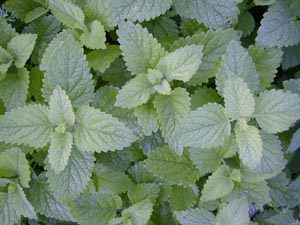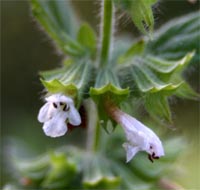
The International Herb Association has designated lemon balm (Melissa officinalis) Herb of the Year 2007. This perennial in the mint family is native to mountainous areas of southern Europe and northern Africa but has naturalized in almost in every warm or temperate area around the globe. The bright green, crinkled leaves have a fragrant lemon-like odor. It is not related to beebalm (Monarda spp.), with which it is sometimes confused.
The plants grow about two feet tall, with branching stems. The oval or heart-shaped, slightly toothed leaves are held tightly in pairs at each stem joint.

The inconspicuous white flowers, sometimes with a yellowish or pinkish tinge, bloom in the leaf axils throughout the summer and are attractive to bees. Because lemon balm is rich in nectar, it is sometimes planted to feed bees.
A few cultivars are available for ornamental use. ‘All Gold’ is a selection with yellow leaves that develops the best color in partial shade. The variety ‘Lime’ has a distinct lime aroma instead of lemon. ‘Variegata’ has dark green leaves with golden yellow markings along the margins, but this fades with the heat of summer and when the plant flowers.

Grow lemon balm in full sun in fertile, well-drained soil. It can be started from seed sown indoors about 4-6 weeks before last frost, although seeds may be slow to germinate if not stratified. Transplanting seedlings into the garden when they are 2-3″ tall. Space the plants 16-18″ apart. You can also sow outdoors in fall or late spring. Plants grow quickly to form large clumps. They may spread somewhat aggressively in some situations and will often self-seed, so deadheading after flowering is recommended to prevent nuisance seedlings. Cutting back hard after flowering will produce a fresh flush of leaves.
Lemon balm can also be propagated by dividing old clumps in spring or early fall, or from cuttings. Replace the plants (if they have lived) after 3-4 seasons, as they generally decline at this time. It may be grown as an annual in areas where it does not survive the winter.
This plant has few insect or disease problems (occasionally it will get powdery mildew) and is rarely, if ever, eaten by deer or rabbits.
To harvest, cut several inches of top growth off the plants at flowering during the first year. On established plants, two or three cuttings may be made in a season. The leaves may be used fresh or dried, although the dried leaves lose much of their aroma. Spread the cuttings on screens in a dark, airy room to dry. Once dry, the leaves can be easily removed from the stems and stored in closed containers.
– Susan Mahr, University of Wisconsin – Madison
Ask Your Gardening Question
If you’re unable to find the information you need, please submit your gardening question here:





 Aster, Symphyotrichum spp.
Aster, Symphyotrichum spp. Fascinating Fasciation
Fascinating Fasciation Alternatives to Lawn: Groundcovers
Alternatives to Lawn: Groundcovers Marigolds
Marigolds


